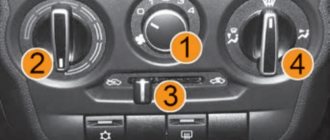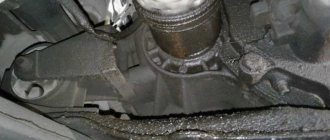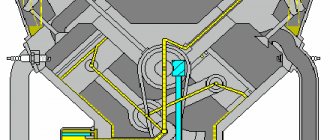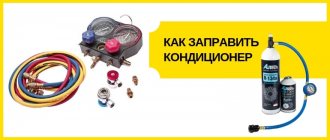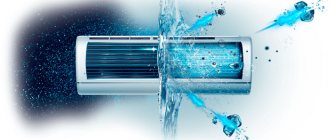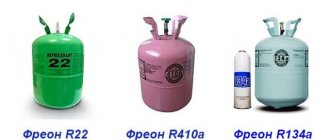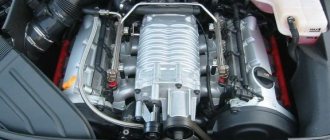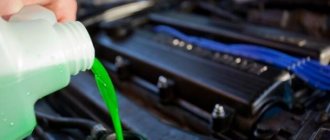Good day everyone! Summer heat is approaching, and therefore it becomes important to use air conditioning for those lucky ones who have it installed in their car. Like any other equipment, it is filled with working fluid, which, like engine oil, periodically requires replacement or renewal. How often do you need to refill the air conditioner in your car? This is exactly what we’ll talk about in this article.
How often should you recharge your air conditioner?
R134a or R1234yf freon circulates inside the air conditioning system of modern cars. Cars produced before 1992 used R132 gas.
Freon of all these types is characterized by high volatility. This means that even in a working system with highly tight connections, freon evaporates into the atmosphere in small quantities. The operating conditions of the car air conditioner also contribute to this – temperature changes, constant vibrations.
With intensive use of the air conditioner, a leak of up to 10% of the filling volume per year is considered normal. Therefore, already 3-5 years after filling, there may not be enough refrigerant in the system for the entire system to operate efficiently. The air conditioner may turn on, but the cooling will be weak. If you have to refill freon every season, there is a large leak in the system that needs to be found and fixed.
History of origin
The desire to get cool, fresh air in his home prompted man to create an air conditioner. But the appearance of this device was preceded by a long history of attempts to create a universal device for monitoring the state of the environment.
Humanity has noticed that cool and fresh air always appears near water. This is how the first prerequisites for the invention appeared. Scientists of ancient Persia invented ventilation shafts, at the bottom of which lay material that absorbed moisture, air evaporation, and groundwater. The air thus humidified entered the houses.
Europe in the 19th century was famous for its attempts to humidify the air using ice plants. Thus, the English scientist W. Whiteley connected a cavity with ice and a fan. The air passed through the ice and thereby cooled.
At the beginning of the 20th century, the first true air conditioner appeared. For the first time, American scientists used refrigerant in the creation - the most important part of the device’s operation. Ammonia and later dielene were used as a refrigerant. Since 1931, freon began to be used. However, the main problems of freon are leakage and evaporation, both at the time of creation and now require additional action - refilling the air conditioner.
Symptoms of Low Refrigerant
- The air conditioner is not very cold.
- When you turn on the air conditioner, a characteristic hissing sound is heard from under the dashboard.
- Unpleasant odor when the air conditioner is running and after it is turned off. The cause of the smell is incomplete cooling of the evaporator. Warmer areas where bacteria and fungus have formed give off a musty, unpleasant odor.
- The air conditioner does not turn on. The control unit registers low freon pressure and therefore blocks the start of the compressor to maintain system functionality.
How can I recharge a car air conditioner?
There are 2 options for refilling the air conditioner.
- Manual filling. The freon cylinder is installed on a digital scale and, using a hose and fitting, is connected to the service fitting of the car's air conditioning system. Scales are necessary to control the mass of gas that has been pumped from the cylinder into the vehicle system. For refueling, a pressure gauge is required to control the pressure in the system and devices for manually introducing oil and dye. Vacuuming is carried out with a special pump, and new oil is injected with a syringe.
- Refueling using an automated station. The hoses of the station are connected to the car's air conditioner through service fittings. Next, the wizard manually selects a maintenance program. A standard list of procedures includes pumping out the refrigerant, checking the high pressure, evacuation, checking for leaks, adding compressor oil, dye, and filling the system with freon.
When using the station, the risk of a master error is minimized. He needs to select a list of processes and adjust the duration of each of them, if necessary.
Freon mass can be determined by the station automatically from the database when entering the vehicle's VIN code or entered manually by the technician. In the latter case, the service technician is guided by the instructions of the air conditioner manufacturer.
Often, when assembling a car, a technical tag is glued in the engine compartment, which indicates the type of freon and the filling volume.
Summarizing
At first glance, recharging the air conditioner in a car is a fairly ordinary and technologically simple task. But upon closer examination, it turns out that this is quite complex and responsible work. First of all, you should clearly understand how to find out when to refill the air conditioner in your car. After all, it is necessary, first of all, to know when the coolant was last changed.
Good to know: How often should you change the spark plugs in a car?
We must not forget about the existing recommendations of large automobile concerns, which clearly justify the period for replacing the refrigerant. And it is very important to know certain signs by which you can judge a malfunction of the interior cooling system. Only by knowing these three information aspects can you promptly and correctly determine when you need to refill the air conditioner in your car.
Which option is better?
Before the advent of automatic stations, manual refueling was the only possible method. If the technician is properly qualified, the result of such refueling will be similar to servicing using an automatic station. But to optimize production and eliminate the risk of a workshop technician’s error, it is more profitable to use automatic stations.
There are some advantages from such a solution for car owners, since professional stations are not only able to make the system cleaner, but also show the actual pressure in the system before refueling, and the amount of freon pumped out. Pressure gauges are installed at each station to show the actual pressure in the high and low circuits. This allows you to assess the cleanliness of the condenser immediately after refueling, correlate the pressure in the high circuit from the moment the fans turn on, and evaluate the performance of the compressor. Due to lower labor costs for owners, refueling using a station costs less and takes less time.
Necessary materials and equipment
Now all car air conditioners are filled with tetrafluoroethane (labeled R-134a), but in the old fashioned way, car enthusiasts still call this refrigerant freon, since the cooling systems of cars produced before the early to mid-90s were filled with CFC-12 freon.
Mixing different types is not allowed; the exact name of the refrigerant can be found on the sticker on the inside of the hood.
A bottle of freon weighing half a kilogram will cost about 1,000 rubles, larger containers will cost several thousand rubles.
For air conditioners in small passenger cars, a bottle of 500 grams is enough, but for larger and more powerful cars you can get by with two bottles
To refuel your car you will need one of the following devices:
- automatic station (costs tens of thousands of rubles);
- single or reusable set of equipment.
Naturally, buying an automatic station when refueling yourself is out of the question - it will cost too much. But it’s worth taking a closer look at the sets. A complete one consists of:
- manifold;
- scales;
- a cylinder filled with freon;
- vacuum pump.
The disposable kit is very inexpensive and includes a bottle, hose and pressure gauge. Also in both cases you will need adapters and fittings.
A disposable kit is cheaper, but less reliable, a reusable kit is the opposite.
The choice between these two options is the car owner's decision.
When should you disinfect your car air conditioner?
We recommend doing bacterial treatment of the air conditioner at least once every 1-2 years. For this purpose, special ozonizers and disinfectants are used, which split the bactericidal liquid with ultrasound, spraying it at the point of air intake. At the same time, the car is started, the air conditioner is turned on and the air recirculation mode is on: the direction of air flow is into the legs and onto the glass. Ozonation helps kill fungus and microbes on the sheathing and carpet. The spray liquid is designed to kill bacteria on the evaporator.
A musty, unpleasant smell when the air conditioner is running or after it is turned off is a clear sign of a clogged evaporator. In this case, disinfection measures are selected based on the degree of contamination. The use of foam cleaners and other disinfectants was discussed in detail by us in the article “Cleaning an air conditioner with your own hands.”
The main signs of the need for urgent refueling
Experienced motorists point out the presence of several main signs indicating the need to refuel the car air conditioner:
- a noticeable decrease in the quality and cooling rate of the air entering the cabin;
- the appearance of oil stains on the surface of freon tubes;
- formation of a layer of frost on the surface of the indoor unit;
- complete absence of cooled air entering the car interior.
If such signs were noticed by a motorist, then it is necessary to immediately begin to solve the problem.
Frequency of condenser cleaning
Condenser is an air conditioner radiator designed to remove heat from compressed freon. It is installed in front of the radiator of the engine cooling system, so it is the first to absorb the impacts of stones and debris when driving at high speed. In addition to bent honeycombs, over time, dirt, fluff and other debris accumulate between the radiators, forming a dense “blanket”. The consequence is insufficient cooling of the condenser and radiator of the engine cooling system. Too high pressure in hot weather causes emergency shutdown of the air conditioner and overheating of the engine.
To wash out all the dirt, the condenser will have to be removed, as well as the intercooler or additional automatic transmission radiator, which can be installed in front of it. Radiators are washed with high pressure water (Kärcher).
After using aggressive chemicals, it should be washed with plenty of running water. Otherwise, chemicals may corrode previously damaged aluminum honeycombs. The stream of water under pressure should be directed strictly perpendicular to the direction of the cells. Otherwise, you risk bending the thin walls between the circulation channels of coolant, freon, and oil.
When using a car primarily in urban areas, experts recommend washing radiators every 2-3 years or 40-60 thousand km. When operating a car on dusty roads or rough terrain, it is recommended to halve the intervals.
Video: Diagnostics and refilling of car air conditioners
Why do you need to change the filter drier?
The filter drier is designed to retain compressor wear products - particles of Teflon seals, metal shavings. Filtration is necessary to prevent clogging of the throttle valve and the entry of abrasive dust into the compressor. The inside of the filter element is filled with silica gel, which absorbs moisture. Water is one of the main enemies of the air conditioning compressor and all moving elements of the system.
It is recommended to change the filter drier for the first time after purchasing a new car after 4-5 years. Since as the hours worked increase, the amount of wear products increases, it is recommended to reduce further intervals to 3-4 years.
There are 2 options for installing a filter drier:
- The filter element is mounted inside the capacitor. It may be closed with a service plug, which is difficult, but can be unscrewed. On many cars with this type of design, the manufacturer does not at all suggest a separate replacement of the filter drier. In this case, it needs to be changed together with the condenser, which significantly increases the cost of servicing the air conditioner;
- Remote filter drier. The filter element is installed in a separate housing, so replacing it does not pose any difficulties.
Preventative measures are always cheaper than repairing faults
Like any component of a car, the air conditioner needs maintenance. For the system to function properly, it is not enough to refill the freon. Periodically you need to wash the radiators, condenser, change the filter drier and disinfect the evaporator.
To prevent the formation of foul-smelling bacteria on the evaporator, turn the temperature control to warm air after operating the air conditioner. 1-2 minutes in this mode will dry the condensate from the evaporator, removing a favorable environment for the growth of bacteria.
Replace the thermostatic valve, throttling valve mesh, compressor shaft seal, pulley bearing, and rubber seals throughout the system as they fail and the first signs of a malfunction/refrigerant leak appear.
